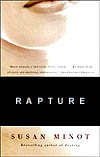 |

|
Rapture
By Susan Minot
115 pp
Knopf Publishing Group, 2002
REVIEWED BY
Erin Fried
|
There is so much of an end to romance these days. The death
knells of many a relationship litter our lives. Susan Minot has found a worthy topic as
she attempts to underscore a particular defective affair in Rapture. Though the subject
is not treated classically, all of the more temporal elements prevail. You’ll find love,
betrayal, agony, and deceit. Sound exciting? In fact, the book reads as more of a study
on self-indulgence than on drama or even consequence. The language, often Minot’s
strongest element, is engagingly stylized but feels distancing. It does little to
satisfy any expectation suggested by the title.
We side with the ever-exploited stock female character and never move from that position.
The novel begins and ends in the bedroom of Kay Bailey where Benjamin Young, her on-again,
off-again secret lover, is enjoying the sexual benefits of their visit. A layer of
invisible ink separates the characters and is never permeated by the reader. Minot
gives us access only to their internal wanderings, asides on how each feels about
their current lovemaking. She fixes a lens upon each individually though not equally,
charting their courses through a relationship that continually perplexes and beguiles
them both.
This is Minot’s fourth full-length effort. While she attempts to present an
edifying look at the space between two people, ultimately the characters are too far
apart to ever do this. The novel succeeds only when the author sets aside the text
and speaks candidly through Kay to illuminate her interior battles and musings.
‘You never knew the state of mind it might put you in. After sex, you might have a
robust, unassailable feeling, or just as easily a small creeping miniscule feeling.
You might have the cardboard feeling of tilting over.’
Such elegant prose extends into everything she writes. Minot is the author of Monkeys,
which won the Prix Femina Etranger award in France in l987, Lust & Other Stories, Evening,
and Folly. The last of these takes place in the early part of the twentieth century and
furthers the groundwork for female struggle, always a topical concern in her writing.
She also co-authored the film Stealing Beauty with Bernardo Bertolucci.
While love has often peppered the literary landscape with thematic elements of heightened
emotion, attention to its finer points is lacking in this novel. There is no sense of
chemistry or intrigue between these characters, only a blind centripetal force propelling
Kay and Benjamin inexplicably toward one another. Minot gives little agency for
their affection, instead focusing on their bitterness. Indeed, the only observable moment of
“rapture” comes when Kay, intent on enjoying this potentially last tryst, is contemplating
the power of sex.
‘“That was worship,” she said.
She turned her face up to him and swallowed. Then, she lay her head back down. The words
shook her. She felt altered in some big nameless way. She stared, not focusing on anything,
stunned.’
When we first meet them, we learn that this is the culmination of years of tense
convergences. Sexual innuendo, tenderness even, have long been replaced with the
discontentment and pain of a dull, unresolved wound. With little to evince their
motivations, Minot conjures the confusion and aggravation of two people who plow
through their interludes as if they themselves were bumper cars and the outside
world an amusement park.
In the present, each appears lost in thought, tracing a private journey on which they were
at odds with each other for most of the time. It is difficult to empathize with either
character, as while they have both felt the damaging blow of heartache and rejection,
neither demonstrates any remorse for having knowingly participated in an affair. That
is, aside from the pain and inconvenience it has cost them individually.
Despite the novel’s ill-traversed plot edges, Susan Minot is exquisite in private moments.
She grants us an affected panorama of a relationship disconnected at its core. With a
quick word or phrase, Minot is able to dissect the advances and retreats of characters
that vacillate between levels of self-knowledge but that steer away from any culpability
that they may have to face. Though we only see their observations, it isn’t hard to expect
that a more complicated struggle lies just slightly beneath the exposed layers. With careful
artistry, she escorts her characters, however partially drawn, toward the next moment.
= THE POTOMAC HOME =
|